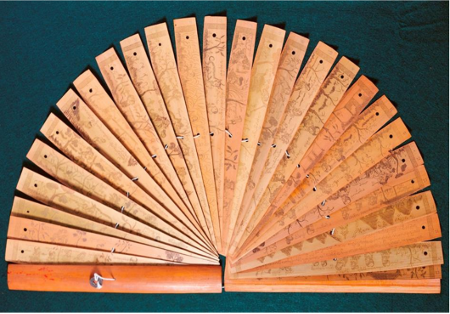This article is taken from Stand 221, 17(1) March - May 2019.
Leaves of Palm and Temples of Language

Image:
Leaves of a Bhimaswarga manuscript from the collection of the Sonobudoyo Museum of Yogyakarta.
Photo courtesy of the Lontar Foundation.
In what is today the Indonesian archipelago, the ‘leaves’ of this maritime region’s first books were actual leaves, made from those of the fan palm (Borassus flabellifer). As is still practised in Bali today, to make these books the leaves are first cut into uniform size, then dried and pressed for up to two years, the end result being a very smooth writing surface. But instead of being written on with pen and ink, the leaves are inscribed with a metal stylus and the incised text is blackened with a paste made from burnt candlenut and coconut oil. In this way, the pages of a manuscript are created, after which the bundle of leaves that form a completed manuscript are perforated with a small hole in three places, one at each end and one just off centre. Thin cords are strung through the holes and tied loosely to keep the leaves together and in order. The leaves are then sandwiched between two flat boards of bamboo or wood of corresponding size, which serve as the covers for the manuscript and have a central hole that is aligned with the middle hole in the leaves. A long cord is threaded through the central hole of both the boards and leaves, the bottom ...

Image:
Leaves of a Bhimaswarga manuscript from the collection of the Sonobudoyo Museum of Yogyakarta.
Photo courtesy of the Lontar Foundation.
In what is today the Indonesian archipelago, the ‘leaves’ of this maritime region’s first books were actual leaves, made from those of the fan palm (Borassus flabellifer). As is still practised in Bali today, to make these books the leaves are first cut into uniform size, then dried and pressed for up to two years, the end result being a very smooth writing surface. But instead of being written on with pen and ink, the leaves are inscribed with a metal stylus and the incised text is blackened with a paste made from burnt candlenut and coconut oil. In this way, the pages of a manuscript are created, after which the bundle of leaves that form a completed manuscript are perforated with a small hole in three places, one at each end and one just off centre. Thin cords are strung through the holes and tied loosely to keep the leaves together and in order. The leaves are then sandwiched between two flat boards of bamboo or wood of corresponding size, which serve as the covers for the manuscript and have a central hole that is aligned with the middle hole in the leaves. A long cord is threaded through the central hole of both the boards and leaves, the bottom ...
The page you have requested is restricted to subscribers only. Please enter your username and password and click on 'Continue'.
If you have forgotten your username and password, please enter the email address you used when you joined. Your login details will then be emailed to the address specified.
If you are already a member and have not received your login details, please email us, including your name and address, and we will supply you with details of how to access the archived material.
If you are not a member and would like to enjoy the growing online archive of Stand Magazine, containing poems, articles, prose and reviews, why not subscribe to the website today?
If you have forgotten your username and password, please enter the email address you used when you joined. Your login details will then be emailed to the address specified.
If you are already a member and have not received your login details, please email us, including your name and address, and we will supply you with details of how to access the archived material.
If you are not a member and would like to enjoy the growing online archive of Stand Magazine, containing poems, articles, prose and reviews, why not subscribe to the website today?


